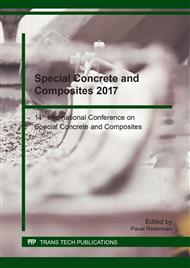[1]
P. Reiterman, O. Holcapek, K. Polozhiy, P. Konvalinka, Fracture Properties of Cement Pastes Modified by Fine Ground Ceramic Powder, Advanced Materials Research 1054 (2014) 182-187.
DOI: 10.4028/www.scientific.net/amr.1054.182
Google Scholar
[2]
J. M. Khatib, Properties of Concrete Incorporating Fine Recycled Aggregate, Cem. Concr. Res. 4 (2005) 763–769.
DOI: 10.1016/j.cemconres.2004.06.017
Google Scholar
[3]
T. U. Mohammed, H. K. Das, A. H. Mahmood, M. N. Rahman, M. A. Awal, Flexural Performance of RC Beams Made with Recycled Brick Aggregate, Constr. Build. Mater. 134 (2017) 67–74.
DOI: 10.1016/j.conbuildmat.2016.12.135
Google Scholar
[4]
C. Medina, M. I. Sanchez de Rojas, M. Frias, Freeze-thaw Durability of Recycled Concrete Containing Ceramic Aggregate, J. Clean. Prod. 40 (2013) 151–160.
DOI: 10.1016/j.jclepro.2012.08.042
Google Scholar
[5]
A. Richardson, K. Coventry, J. Bacon, Freeze/thaw Durability of Concrete with Recycled Demolition Aggregate Compared to Virgin Aggregate Concrete, J. Clean. Prod. 2 (2011) 272–277.
DOI: 10.1016/j.jclepro.2010.09.014
Google Scholar
[6]
R. Zaharieva, F. Buyle-Bodin, E. Wirquin, Frost Resistance of Recycled Aggregate Concrete, Cem. Concr. Res. 10 (2004) 1927–(1932).
DOI: 10.1016/j.cemconres.2004.02.025
Google Scholar
[7]
M. Sefflova, T. Pavlu, The Durability of Fine Recycled Aggregate Concrete, Advanced Materials Research 1144 (2017) 59-64.
DOI: 10.4028/www.scientific.net/amr.1144.59
Google Scholar
[8]
CSN EN 1015-3, CSN EN 1015-3: Methods of Test for Mortar for Masonry - Part 3: Determination of Consistence of Fresh Mortar (by Flow Table), Prague: Czech Standards Institute, 2000 (in Czech).
DOI: 10.3403/01541440
Google Scholar
[9]
CSN EN 12390-3, CSN EN 12390-3 Testing Hardened Concrete - Part 3: Compressive Strength of Test Specimens (in Czech), Prague: Czech Standard Institute, (2009).
Google Scholar
[10]
CSN EN 12390-5, CSN EN 12390-5 Testing Hardened Concrete - Part 5: Flexural Strength of Test Specimens (in Czech), Prague: Czech Standards Institute, (2009).
Google Scholar
[11]
CSN731322. Determination of Frost Resistance of Concrete. Prague: Czech Office for Standards, Metrology and Testing, 1968 (in Czech).
Google Scholar


